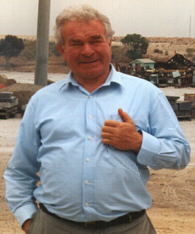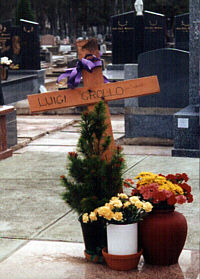Big Smoke on Thin Ground
Source
’Big Smoke on Thin Ground’ Dialogue March (1996)
As is well known, there is said to be a grave somewhere in England that is distinguished not by a magnificent monument of a mournful setting but by a short inscription: ’The Unhappiest One’. It is said that the grave was opened, but no trace of a corpse was found.
Kierkegaard Either-Or 1843, p. 219
 Last
summer, I attended the memorial service for Frank Thring at the Victorian
Arts Centre. The plush velvet and brass environs of the cultural institution
seemed quite an odd setting for the old time theatre world that were in
attendance that day. In the end, we were marking not just the passing
of one individual, but the disappearance of an entire generation of Melbourne
thespians, marooned by television. Of course, Frank Thring went beyond
that. He groaned and glowered his way on the Hollywood stage—
but, unlike today’s Mel Gibsons and Nicole Kidmans, he returned as
a living legend of the grand Melbourne. It seems a lost city now, this
Melbourne of vulnerable dignity. The "Paris end of Collins Street"
is just a faded postcard. And Her Majesty’s Theatre is just a international
depot for Andrew Lloyd Webber musical packages.
Last
summer, I attended the memorial service for Frank Thring at the Victorian
Arts Centre. The plush velvet and brass environs of the cultural institution
seemed quite an odd setting for the old time theatre world that were in
attendance that day. In the end, we were marking not just the passing
of one individual, but the disappearance of an entire generation of Melbourne
thespians, marooned by television. Of course, Frank Thring went beyond
that. He groaned and glowered his way on the Hollywood stage—
but, unlike today’s Mel Gibsons and Nicole Kidmans, he returned as
a living legend of the grand Melbourne. It seems a lost city now, this
Melbourne of vulnerable dignity. The "Paris end of Collins Street"
is just a faded postcard. And Her Majesty’s Theatre is just a international
depot for Andrew Lloyd Webber musical packages.
Of any life in Melbourne, Frank’s seemed worthy of some monumental presence. One of the anecdotes recounted during the memorial was his response to an interviewer’s question about what he would like as his epitaph. Frank said he would prefer the words: ’Frank Thing [dramatic pause] Lived’. What a gift to the city such a gravestone would be. What a respite to the racing cars, spinning roulette wheels and pokies— to stumble across the grave of a person whose presence so towered above his life.
Eager to follow up this possibility, I made some calls the next day to discover what had been arranged. I was aware that his estate was being auctioned and the funds were dedicated to a scholarship for young actors, but I assumed some friends would put together the money necessary to mark the occasion. You can imagine the disappointment on hearing that— at the actor’s behest— Frank’s ashes were scattered at sea from the coast of Queenscliff.
But it’s mean to complain about this minor detail while so many projects of real stature are animating Melbourne— CityLink, the new Crown Casino and the visionary new Museum of Victoria. The life of a solitary individual is surely ephemeral compared to the huge flows of capital that are coursing through the city. If we were interested in finding evidence of some memorial impulse left in Melbourne, we should perhaps look not to the front stage but the burgeoning skyline.
Near the end of that year, an half-page advertisement appeared in The Age dedicated to the recently deceased Luigi Grollo, the father of Bruno. This is more like it. The life of the post-war Italian migrant is an epic chapter in our history. Luigi comes to Australia with nothing and is quickly exploited as cheap labour. He struggles to muster the rudiments necessary to raise a family in inner-suburban Melbourne. From this hard-sprung new life, his children shoot like arrows into successful careers. His son becomes the one individual who transforms Melbourne from a demur city of Victorian grace to a sublime avenue of individual ambition— but he does not cross the river and stays in Thornbury. Thanks to Luigi, we can marvel at the Rialto tower ablaze in the setting sun.
The advertisements and obituaries— again,
something more substantial seemed appropriate. Something that you could
stumble across well after the newspapers had been recycled and lost. I
rang the company who in some respects are the inverse of Grollo Constructions:
Giannerelli & Sons, the monumental masons responsible for the unreal
estate of the Italian dead in Melbourne. If you haven’t seen their
remarkable display at the corner of Nicholson and Johnston Street, Fitzroy,
then you must have seen the baroque results of their labours in cemeteries
of Melbourne.  According
to John Giannerelli (the Bruno Grollo of the afterlife), the Grollo family—
in their customary modesty— have a family mausoleum
already built at Preston cemetery, and if I wanted to see where Luigi
Grollo had been laid to rest, then I should go there.
According
to John Giannerelli (the Bruno Grollo of the afterlife), the Grollo family—
in their customary modesty— have a family mausoleum
already built at Preston cemetery, and if I wanted to see where Luigi
Grollo had been laid to rest, then I should go there.
I didn’t anticipate any trouble. Surely I would be able simply to walk in through the gates and be immediately overwhelmed by the pyramid-like Grollo monument, a fitting resting place for the family that gave this city its elevator to heaven. But I didn’t quite expect to see the entire cemetery filled with such elaborate monuments. In the spectral shadow of the bland northern suburbs, here were temples, modernist sculptures, an entire necropolis of grandeur.
But no Grollo monument. What was up? I found a man in a white boilersuit near a truck and assumed he was a grave digger. I explained my predicament, ready to be embarrassed at having overlooked something quite grand. He looked at me suspiciously— ’What’s it worth to you?’ He was asking me for a bribe. We worked out something nominal, and he guided me up one of the aisles. Instead of a towering statue, he pointed to what was the most modest grave in the entire cemetery. On a slab of plain pink marble, next to his wife, was a wooden cross with the words ’Luigi Grollo’ handwritten on it. Was this some joke?
 The
grave digger sniggered. ’Down there, they’re all the same. Doesn’t matter
what you do in life. In the end it’s the same’. Yes, you might expect
that kind of irony from a grave digger, even if the line sounded a little
over-rehearsed. There was, however, something at work here which went
before death as the universal fate of kings and paupers.
The
grave digger sniggered. ’Down there, they’re all the same. Doesn’t matter
what you do in life. In the end it’s the same’. Yes, you might expect
that kind of irony from a grave digger, even if the line sounded a little
over-rehearsed. There was, however, something at work here which went
before death as the universal fate of kings and paupers.
There was a kind of inversion at work too. None of the families accommodated by the grand tombs around me are likely to have left an enduring mark on Melbourne. Except in the cemetery. When you give the very skyline of a city your family’s imprimatur, you don’t need anything special in the last resting place.
Roulette wheels and roundabouts, skyscrapers and cemeteries. In the end, as archaeologists dig through the ruins of Melbourne, it may not be today’s heroes whose mark remains on history, but the machinists and brickies whose names are etched into monuments of toil. Requiescent in pace.
Listen to John Giannarelli, monumental mason, speak about the stones of Melbourne on RealAudio 3.0
(originally produced for Arts Today on ABC Radio National)

Copyright held by author Kevin Murray
For permission to reproduce this article, please contact Kevin
Murray